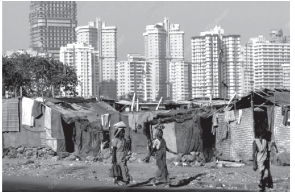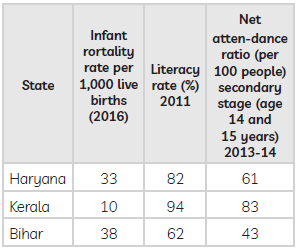Please refer to the Case Study Questions Chapter 1 Development with answers provided for Class 10 Social Science. These solved case study based questions are expected to come in the Class 10 Economics exam in the current academic year. We have provided Case study for Class 10 Social Science for all chapters here. You should practise these solved case studies to get more marks in examinations.
Chapter 1 Development Case Study Questions Class 10 Social Science
1. Read the source given below and answer the following questions:
Once it is realised that even though the level of income is important, yet it is an inadequate measure of the level of development, we begin to think of other criterion. There could be a long list of such criterion but then it would not be so useful. What we need is a small number of the most important things. Health and education indicators, such as the ones we used in comparison of Kerala and Haryana, are among them. Over the past decade or so, health and education indicators have come to be widely used along with income as a measure of development. For instance, Human Development Report published by UNDP compares countries based on the educational levels of the people, their health status and per capita income. It would be interesting to look at certain relevant data regarding India and its neighbours from Human Development Report 2019.
Answer the following MCQs by choosing the most appropriate option.
(i) The Human Development Report compares countries on the basis of:
(a) The educational levels of the people
(b) Health status of the people
(c) Per capita income of the people
(d) All the above factors
Answer
D
(ii) Which one of the following criteria is the basis to measure the development of a country according to UNDP?
(a) Per capita income
(b) Educational levels of the people
(c) Health status of the people
(d) All the above
Answer
D
(iii) HDI stands for:
(a) Heavy Developed Industry
(b) Human Development Index
(c) Heavy Developed Infrastructure
(d) Heavy Industries Development
Answer
B
(iv) Which organisation publishes the Human Development Report:
(a) WHO
(b) UNDP
(c) WTO
(d) IMF
Answer
B
2. Read the source given below and answer the following questions:
For comparing countries, their income is considered to be one of the most important attributes. Countries with higher income are more developed than others with less income. This is based on the understanding that more income means more of all things that human beings need. Whatever people like, and should have, they will be able to get with greater income. So, greater income itself is considered to be one important goal. Now, what is the income of a country? Intuitively, the income of the country is the income of all the residents of the country. This gives us the total income of the country. However, for comparison between countries, total income is not such an useful measure. Since, countries have different populations, comparing total income will not tell us what an average person is likely to earn. Are people in one country better off than others in a different country? Hence, we compare the average income which is the total income of the country divided by its total population. The average income is also called per capita income.
Answer the following MCQs by choosing the most appropriate option.
(i) What is the most important attribute while comparing countries?
(a) Their population
(b) Their political status
(c) Their income
(d) None of the above
Answer
C
(ii) Per capita income is :
(a) Income per person
(b) Income per family
(c) Income per earning person
(d) Income per month
Answer
A
(iii) The average income is also called:
(a) Per capita profit
(b) Per capita income
(c) Limited income
(d) None of the above
Answer
B
(iv) In World Development Reports, brought out by the World Bank, which criterion is used in Classifying countries?
(a) Total income
(b) Gross income
(c) per capita income
(d) Net income
Answer
C
Data analysis questions:
1. Read the given data and find out which country has most equitable distribution of income.

(a) Country A
(b) Country B
(c) Country C
(d) Country D
Answer
A
2. Read the given data and find out which country has most equitable distribution of income.

(a) Country A
(b) Country B
(c) Country C
(d) Country D
Answer
A
3. Read the given data and find out which country has most equitable distribution of income.

(a) Country A
(b) Country B
(c) Country C
(d) Country D
Answer
C
Very Short Answer Type Questions
Question. Study the picture and answer the question that follows:

What could be the development goal for the shown area?
Ans. The developmental goal for the people living in a slum will be provision of sturdy but affordable houses and other living conditions including food, water and health facilities.
Question. What may be a developmental goal of farmers who depend only on rain for growing crops ?
Ans. The development goal of a farmer who is only dependent on rain for growing crop, would be a good and suffcient monsoon season so that his crops get the required irrigation and he can benefit from the good produce.
Question. Study the table and answer the questions given below :
Some comparative data on Haryana, Kerala and Bihar

Sources : Economic Survey, 2017-18 Vol. 2, Government of India; National Sample Survey Organisation
Question : In comparison to Kerala, which state has the highest infant mortality rate ?
Ans. Bihar
Question. Study the statistics in the table and Answer the question that follows:

Ans. 10,000
Question. Define the term ‘per capita income’.
Ans. Per capita income is calculated as the average income of a citizen of a country. Per capita Income = total income of a country/ total population
Question. Who wrote ‘Small is Beautiful’?
Ans. Schumacher wrote ‘Small is Beautiful’.
Question. Define the term ‘literacy rate’.
Ans. Literacy rate measures the proportion of literate population in the 7-and-above age group in a country. The higher the literacy rate, the more the development in the country.
Question. How can two people have different developmental goals ?
Ans. Different people have different developmental goals because people come from different backgrounds and have different dreams and aspirations.
Question. What may be a developmental goal of the urban unemployed youth?
Ans. The development goal of an urban unemployed youth would be to find a good job and earn a decent wage with that work. He/she will aspire to maintain a good standard of living.
Question. Define IMR.
Ans. The number of children that die before the age of one year as a proportion of 1000 live children born in that particular year, is called infant mortality rate or IMR.
Question. Study the table and answer the question given below:

Question: Which State has the lowest net attendance ratio at the secondary stage?
Ans. Bihar
Question. Mention the formula to calculate the BMI (Body Mass Index).
Ans. BMI- (BODY MASS INDEX) Weight of person in kg and height in metres is taken. Divide the weight by the square of the height.
Question. The total number of children of age group 14 and 15 years attending school as a percentage of total number of children in the same age group is referred as …………………… .
Ans. Net Attendance Ratio.
Question. What may be one of the developmental goals of a girl who belongs to a rich urban family?
Ans. The developmental goals of a girl who belongs to a rich urban family may be getting the same freedom as her brother, pursue higher studies and a high standard of living.
Question. Based on the data given in the following table, calculate the average income for both countries: Which country has more equitable distribution of income?

Ans. (A) 10,100 (B) 10,100 Even though, average income of both countries is equal, Country A possesses a more equitable distribution of income and less economic disparities accordingly.
Question. What criteria does UNDP compare to measure the human development index?
Ans. UNDP compares countries based on the educational levels of the people, their health status and per capita income.
Question. Study the picture given above. Identify an appropriate developmental goal for the characters.

Ans. An appropriate developmental goal for the poor lady would be to have a stable job and affordable house for her small family. For the rich man, his developmental goal can be more opportunities for profit and investment from foreign countries, more luxurious life or even a bigger car.
Question. What may be one of the developmental goals of a rich farmer?
Ans. The developmental goals of a rich farmer might be gaining high profits on the produce or availability of cheap labour to work in the farm.
Short Answer Type Questions
Question. “Money in your pocket cannot buy all the goods and services that you may need to live well.” Justify the statement with example.
Ans. It is true because income by itself is not a completely adequate indicator of material goods and services that citizens are able to use. For example, money cannot buy us a pollution-free environment or ensure that we would get unadulterated medicines. Money may also not be able to protect us from infectious diseases, unless the whole of our society takes preventive steps. 46. Explain the three components of Human Development Index. Ans. Components of HDI
(1) Life expectancy
(2) Literacy rate
(3). Per capita income These three to be explained.
Question. Suggest any three ways to improve public facilities in India.
Ans. Public facilities are the base for any kind of development. Three ways to improve public facilities in India are:
(1) One of the most essential facility is education. Easily accessible and affordable education must be provided to all the children of the country, irrespective of their caste, class or gender. More government and public schools should be opened, tuition fee should be reduced and education must be made free up to elementary level.
(2) Public Distribution System should be reformed to include people from the remotest of areas. Corruption should be checked and the food grains provided should be rigorously monitored for quality.
(3) Health facilities should be made free to children below 10 years of age and senior citizens, disadvantaged classes etc.
(4) Transport facility must be available to everyone, easily, even in the remotest of areas. The availability of transport facility makes commute affordable and hence brings down the cost of accessing regular commodities.
Question. How do different people have different developmental goals? Explain with examples.
OR
“What may be development for one may not be development for the other. It may even be destructive for the other.” Analyse the statement.
Ans. Different people have different developmental goals because:
(1) People come from different economic and social backgrounds and their priorities and aspirations vary.
(2) People set their goals according to the changing circumstances and the prevailing situation. For example, a rich family would always want to earn more luxuries, but if they suddenly suffer a huge loss, their developmental goals will change to first securing a stable source of income, ensuring education for their children, etc.
Question. What is Per Capita Income? Can Per-Capita Income be considered real income of a citizen?
Ans. To calculate income of every citizen in a country is difficult therefore an average income is calculated by dividing the total income of the country by its total population. This average income is also known as per capita income or average income of every citizen in a country. Per capita income however is not the real income of a citizen but an estimate.Per capita income doesn’t prove to be a reliable unit to measure whether or not a citizen is developing in a country.
Question. Beside income, what can be the other attributes to compare development?
Ans. Income is not only the criterion but it is one of the important indicators of economic develop-ment. Some of the others attributes can be: Infant Morality Rate: It is an indicator of the availability of doctors and medical facilities for pre, post and natal care in the region. Low infant mortality rate indicates good medical facilities and all round development in the society. Literacy Rate: This indicates the availablity and accessibility of educational institutions in rhe region to all age groups and genders. It indicates the mentality of the people, whether there’re socially developed and updated or not. Low literacy rate shows less development. Life expectancy: This indicates the availability of health facilities throughout one’s life, whether the region has sanitized, safe surroundings to sustain. Low life expectancy means that the region lacks items for a healthy living.
Question. Suggest and explain any three ways to reduce the use of petrol.
Ans. To save petrol, the following steps can be taken:
(1) Using public transports: People should avoid using personal vehicles unless the distance is a lot and public transport is not available. Using public transport can save a lot of petrol. (2) Use of alternative clean energy sources: Cleaner and easily available sources of energy like natural gas can also help save petrol.
(3) Car pooling: Walking short distances for groceries and other work instead of pulling a two/four-wheeler everywhere should be encouraged. If the destination is the same, carpooling can be used to save fuel.
(4) Electric vehicles: People should consider switching to electric vehicles to save fuels. Electric vehicles are safe and cause almost no pollution. They can be charged at charging points which can be conveniently installed for the purpose
Long Answer Type Questions
Question. What should India do or achieve to become a developed country? Explain.
Ans. India should focus on the following points to become a developed country:
(1) It should reduce the gap between rich and the poor.
(2) It should make provision for accommodating all its existing able people in jobs to get a suitable job.
(3) Primary health and education must access to all even in the remote parts of the country.
(4) Government should make provisions for making the country self-reliant by providing skill education to all.
(5) Government should encourage smallscale and cottage industries by giving cheaper credits and training to those who are willing to be the entrepreneurs.
Question. What is human development? Explan its indicators.
Ans. Human development can be seen as a ‘human-centred’ approach towards development which focuses on measurement of values like satisfaction, literacy, harmony, peace, freedom and happiness of people. It is concerned with the people and their wellbeing and fulfillment of their needs, choice and aspirations. Human development is measured by various indicators:
(1) Per Capita Income – World Bank measures human development by measuring Pthe per capita income or average income per citizen of a country. High per capita vouches for better capacity of citizens to avail facilities. Low per capita signals poverty and less development.
(2) Literacy rate – UNDP measures literacy rate to calculate whether a country is developed or not. Higher literacy rate means easy availability of educational facilities which signals better development.
(3) Infant mortality rate – Less infants dying due to abundance of medicinal and natal and post-natal facilities available easily to all citizens signal that the government of the country has provided adequate health facilities which translate to development.
(4) Net attendance ratio – This is also an important indicator. More attendance at school means greater literacy and better development.
Question. What is national development? What are the aspects covered under the National development?
Ans. National development refers to the improvement of the life standards of a country’s citizens through actualization of their different developmental goals: provision of a healthy, free, safe and dignified life to every citizen without any discrimination.
(1) Under national development, the government decides what would be a fair and just for all citizens.
(2) Under National development,only those programmes and policies are implemented which
(3) would benefit maximum number of people..
(4) Under national development, national interests are prioritised over self interests.
(5) National development also entails inclusivity of citizens in decision making, provision of compulsory health and educational facilities, affordable housing and food for every citizen. (6) National development also entails invoking feelings of belongingness, national unity among all communities.
Question. ‘Per capita income is not considered a true measure of development.’ Comment.
Ans. When the total income of a country is divided by its total population, it is called per capita income or average income. It is not considered a true measure of development because of the following reasons:
(1) It does not tell us how this income is distributed as population is a variable component.
(2) Life expectancy and infant mortality rate can be used as other criteria for measuring development.
(3) Literacy rate and health status of people in the country can be the other criteria for measuring development.
(4) Corruption free society, gender equality, pollution free environment, investment in the health and education sector etc. can be the other indicators of measuring development.
Question. Suggest some of the developmental goals for your locality or place you are residing?
Ans. The developmental goals for my locality can be as follows:
(1) There should be a primary health centre in the locality.
(2) There should be a school catering quality education up to higher secondary level for the children living nearby.
(3) Government should construct pucca houses for people to be given them on subsidized cost.
(4) All weather roads in the locality must be constructed and well maintained by the authority responsible for it.
(5) There should be a provision of potable drinking water in each house in the locality.



